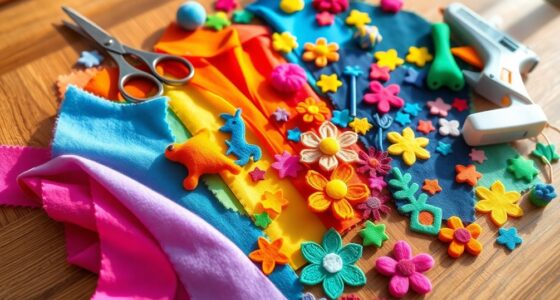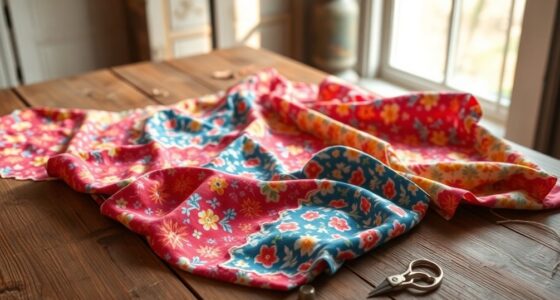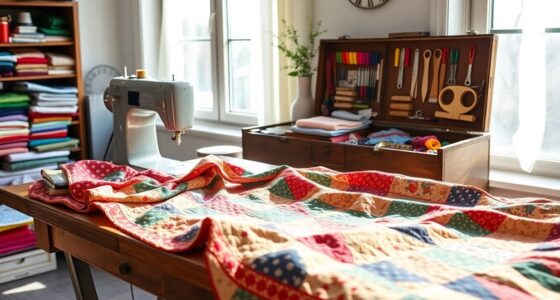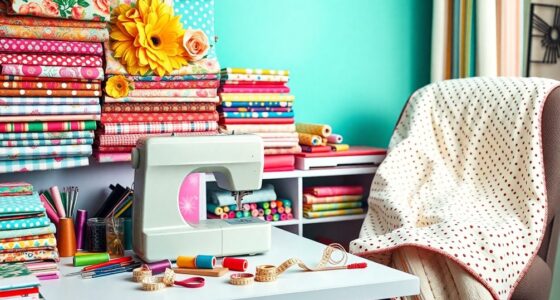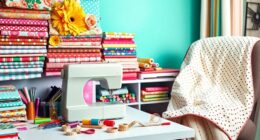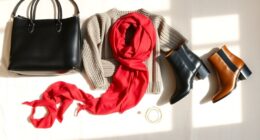To find the perfect fabric for your next DIY project, start by defining the project's purpose—functional or decorative. Choose durable fabrics for functional items and lighter, patterned ones for decorative pieces. Pay attention to fabric drape and flexibility, which affect fit and appearance. Don't forget to take into account care requirements and your budget. Evaluating fabric options before buying helps guarantee you're making smart choices. Keep exploring to uncover more tips that can guide your selection process!
Key Takeaways
- Determine the purpose of your project to select the appropriate fabric type, whether functional or decorative.
- Evaluate fabric drape and flexibility to ensure it aligns with the desired fit and style of your creation.
- Check fabric care requirements to ensure longevity and ease of maintenance for your finished project.
- Set a budget and explore online options to find a variety of fabrics while considering shipping costs.
- Read customer reviews and assess fabric qualities before purchasing to avoid potential issues with your chosen materials.
Understanding Your Project's Purpose
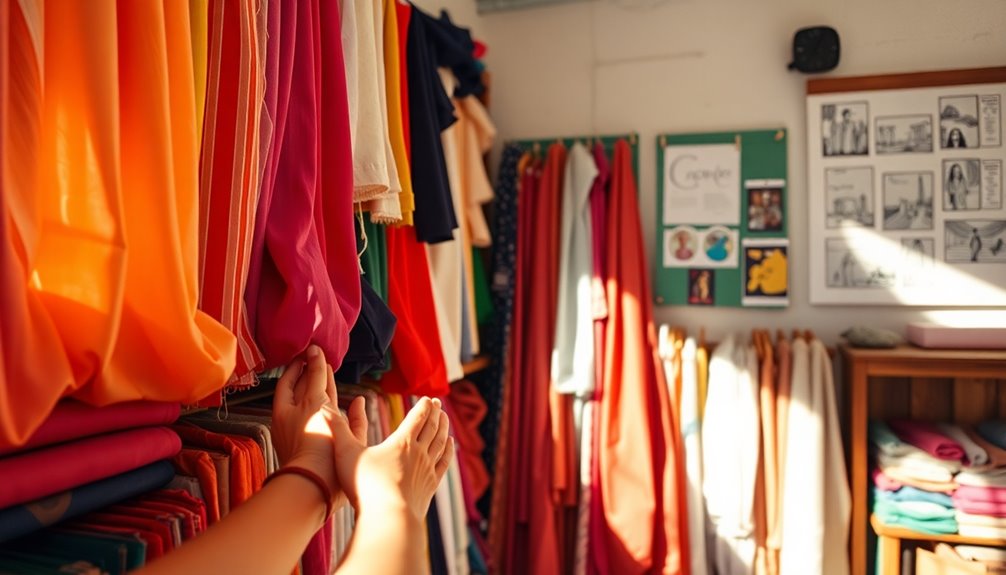
When you're diving into a DIY project, have you considered the purpose behind it? Defining whether your project is functional or decorative is essential for effective fabric selection.
For functional items like bags or clothing, you'll want to choose durable fabrics such as canvas or denim that can handle frequent washing and wear.
On the other hand, if you're working on decorative projects like throw cushions or wall hangings, lighter fabrics with intricate patterns can enhance your aesthetic appeal.
Remember to think about environmental factors, too—will your item be used outdoors or need regular cleaning?
Understanding your project's purpose helps you select the right fabric types, elevating the quality and satisfaction of your finished creation.
The Importance of Fabric Drape
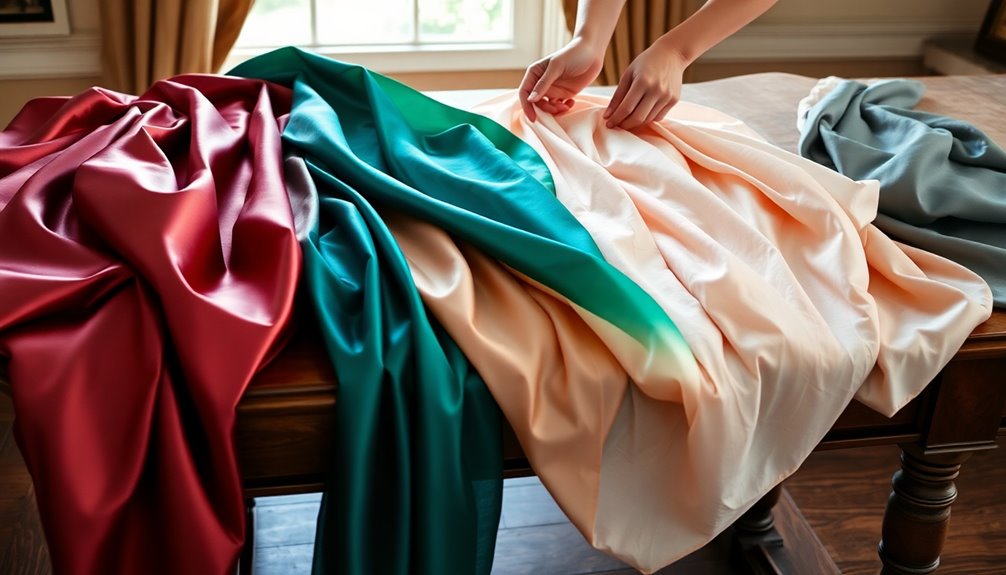
Choosing the right fabric isn't just about color or pattern; it's also about how the material behaves.
Fabric drape considerably influences how your garment fits and looks. When you're choosing a fabric, consider the following:
- Heavier fabrics provide structure for items like jackets and bags.
- Lightweight fabrics create a flowy effect perfect for dresses and skirts.
- Fabrics with poor drape can make clothes appear shapeless or unprofessional.
- Test fabric drape by holding it up and observing how it hangs.
- Understanding drape helps you enhance both usability and aesthetics.
Evaluating Fabric Flexibility
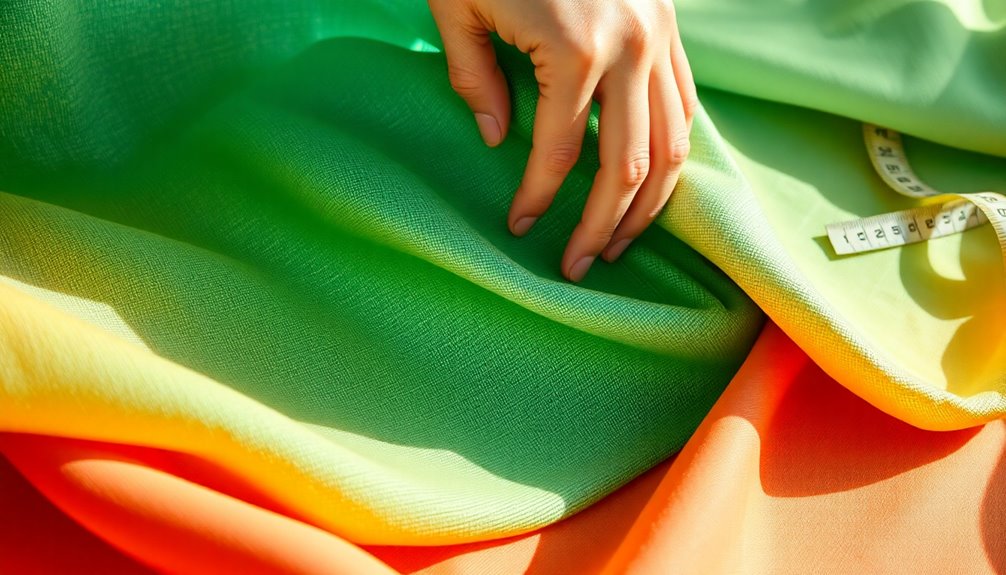
How can you tell if a fabric will work for your project? Start by evaluating fabric flexibility. Gently pull the material in both directions. If it stretches well, it's likely a good choice for form-fitting clothing like t-shirts or leggings, especially if it's a stretchy material like jersey or lycra.
On the other hand, if it has minimal stretch, it's better suited for structured items such as bags or home decor. Fabrics with good drape, like silk and viscose, can also enhance the flow of dresses and skirts.
Considering Fabric Care Requirements
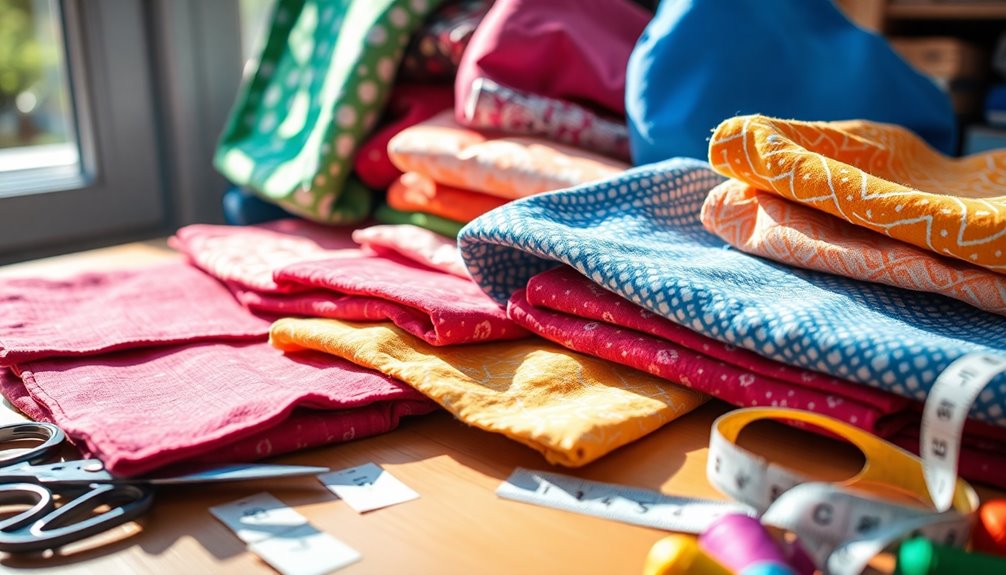
What should you keep in mind about fabric care requirements before diving into your DIY project? Different fabrics have unique care needs, and knowing these can save you time and effort later.
Here are some key points to take into account:
- Check if the fabric is machine washable or requires hand washing.
- Delicate fabrics like silk need gentle care, often involving dry cleaning.
- Pre-wash fabrics prone to shrinking, like wool, to maintain size and shape.
- Fabrics like polyester and nylon resist wrinkling and fading, making them easier to care for.
- Always refer to the fabric's care label for specific washing instructions to prolong its life.
Matching Fabric to Your Skill Level
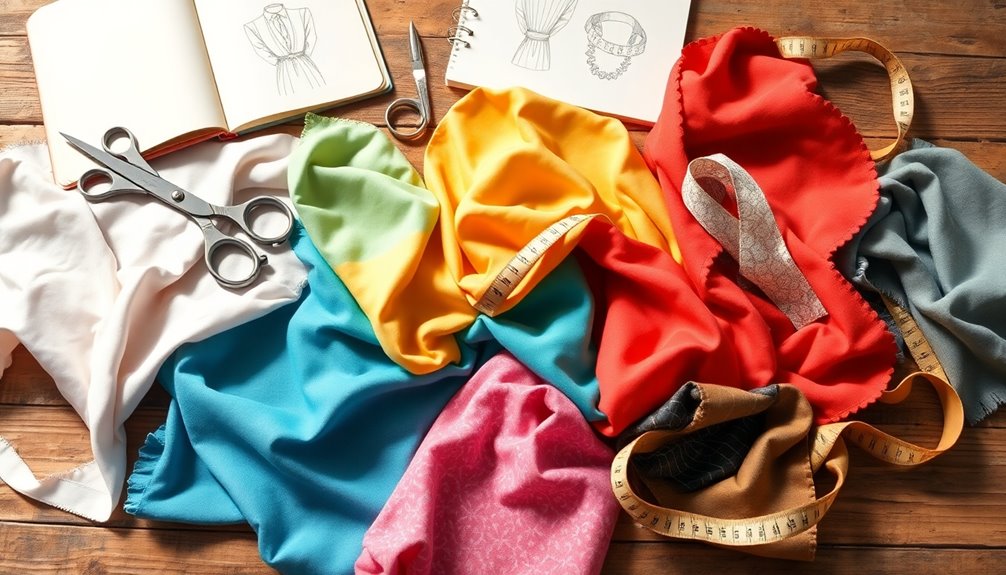
Understanding fabric care requirements helps set the foundation for your DIY projects, but matching the right fabric to your skill level is equally important for success.
If you're a beginner, focus on choosing fabrics that are easy to sew, like cotton or linen. These materials offer good structure and are forgiving of mistakes.
For intermediate sewists, fabrics with a little stretch, such as jersey knits, allow more flexibility in fitting garments.
Once you're comfortable, you can experiment with more delicate fabrics like silk or chiffon, which require advanced techniques.
Always practice with small fabric scraps before tackling larger projects to build your confidence and skill.
Knowing the characteristics of different types of fabric will help you make informed choices that suit your abilities. Additionally, consider the impact of color theory on your fabric selections, which can enhance your overall project outcome.
Exploring Different Fabric Types
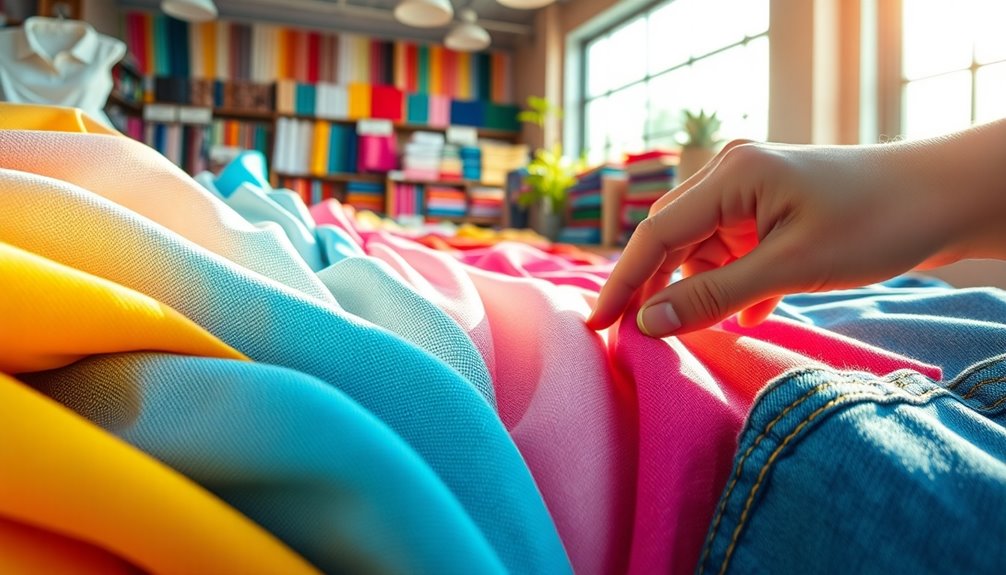
When you plunge into the world of DIY projects, exploring different fabric types can open up a range of creative possibilities.
Each fabric brings its own unique qualities, making your sewing project exciting and diverse. Here are some fabrics to take into account:
- Cotton Fabric: Versatile and easy to sew, available in many prints and weights.
- Linen: Breathable and softens with wear, perfect for garments and decor.
- Denim: Durable and sturdy, ideal for long-lasting items.
- Knit Fabrics: Stretchy and comfy, great for fitted garments but require specific sewing techniques.
- Silk: Luxurious and elegant, though a bit tricky to work with.
Choosing the right fabric not only enhances your project but also boosts your sewing skills.
The Role of Color and Texture
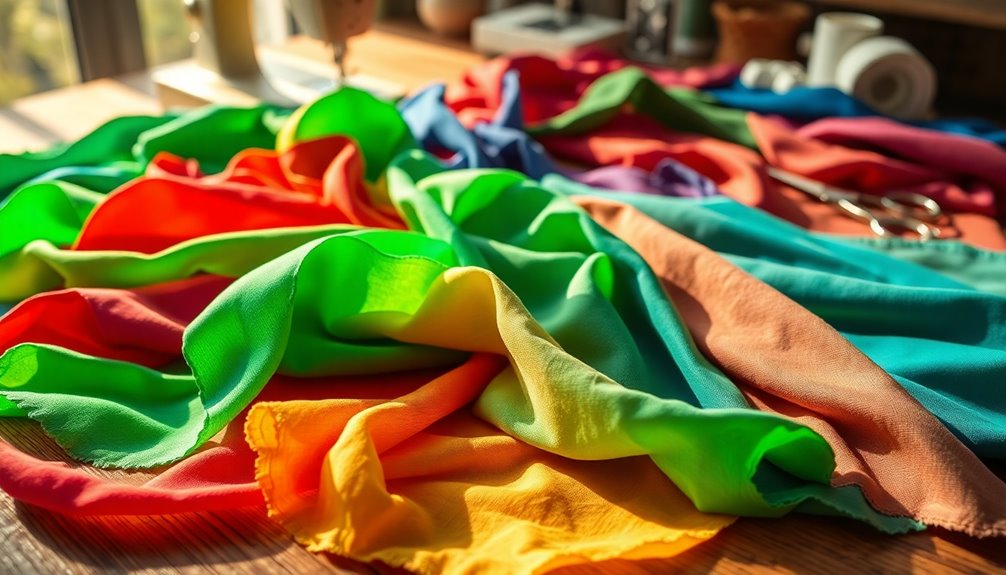
Color and texture are essential elements that can elevate your DIY projects from ordinary to extraordinary. The right color can dramatically enhance the overall aesthetic, so make sure to check fabric colors under natural light for the best match with your design vision and skin tone.
Texture plays a crucial role in the look and feel of your fabrics. Soft materials like silk provide luxury, while firmer options like cotton twill offer structure.
Consider how color and texture interact; a textured fabric can add depth to solid colors, making your garments and accessories more visually interesting. Vibrant patterns can turn a simple design into a statement piece, while neutral textures serve as a versatile backdrop for bolder elements in your project.
Budgeting for Your Fabric Purchase
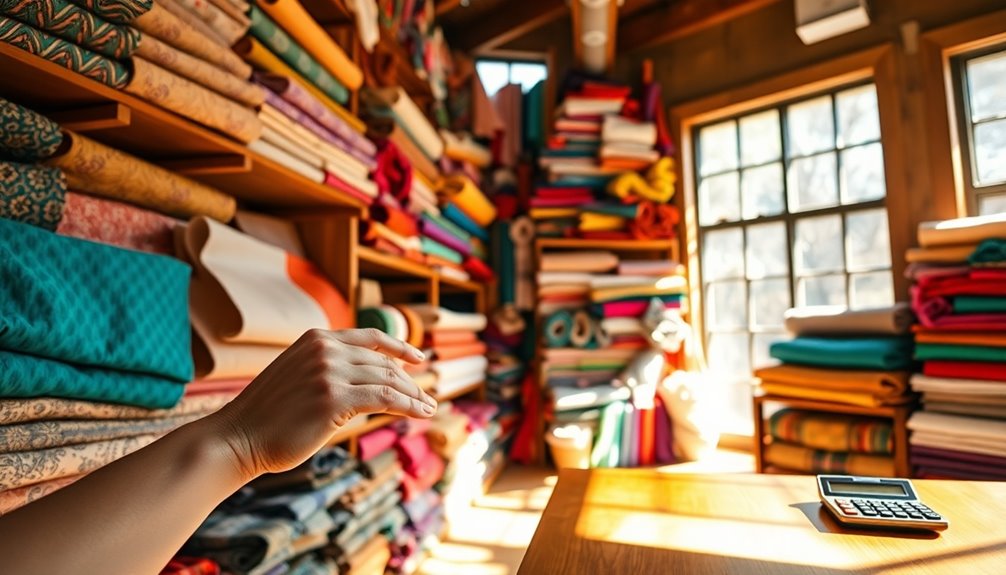
When you're setting a budget for your fabric purchase, it's essential to know the average cost per yard and factor in any extra supplies you might need.
Don't forget to explore discount options like second-hand fabrics or remnant sales to stretch your dollars further.
Keeping your project size in mind also helps prevent overspending while allowing for adjustments if needed.
Set a Budget
Setting a budget for your fabric purchase is essential to guarantee your DIY project doesn't break the bank. Start by outlining all potential costs to effectively set a budget:
- Research average fabric prices at your local fabric store or online.
- Include the cost of special fabrics, like silk or premium denim.
- Add in thread and any additional supplies you need.
- Consider second-hand fabrics or remnants for unique and affordable options.
- Don't forget about shipping costs if you're ordering online—they can add up quickly!
Explore Discount Options
After establishing a budget, it's time to look for ways to stretch your fabric dollars even further. Here are some practical options to evaluate:
| Option | Description | Benefits |
|---|---|---|
| Local Fabric Shops | Explore local fabric shops for seasonal sales. | Access quality materials at reduced prices. |
| Fabric Swaps | Join community events to exchange unused fabrics. | Acquire unique materials for free. |
| Online Fabric Stores | Utilize online stores with promotions and discounts. | Find great deals and loyalty rewards. |
| Clearance Sections | Check clearance sections in-store and online. | Discover high-quality fabrics at lower costs. |
Sourcing Quality Fabrics
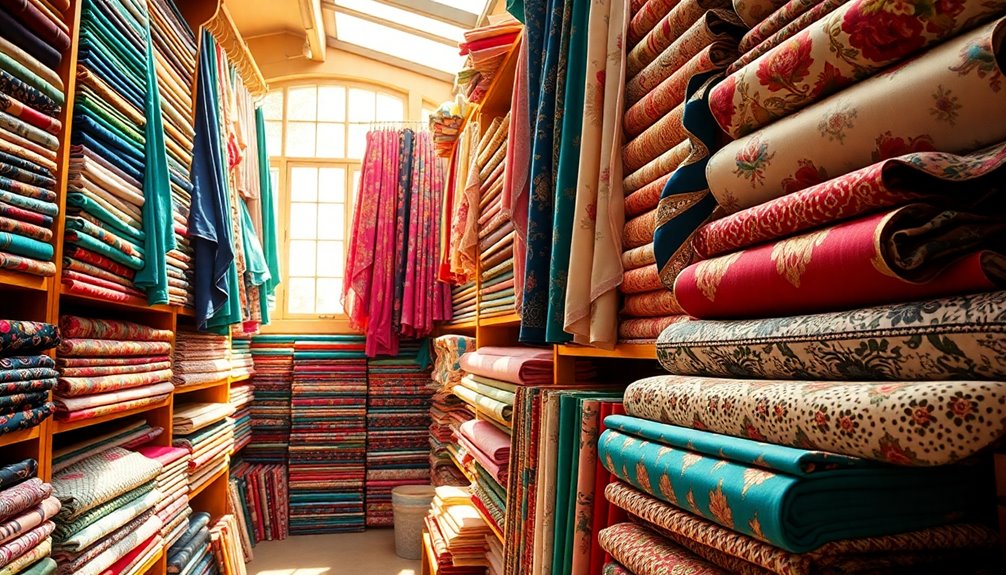
Sourcing quality fabrics is essential for achieving the best results in your DIY projects.
Whether you're visiting local shops or browsing online retailers like Sahni Fabs, consider these tips:
- Choose the right fiber: Opt for natural fibers like cotton or linen for breathability, or synthetic fabrics for durability.
- Engage with staff: Knowledgeable shop staff can offer insights and tailored recommendations.
- Explore fabric swaps: These events can lead to unique finds and sustainable options.
- Check remnant sales: Often, you can snag quality materials at reduced prices.
- Read customer reviews: Online stores provide feedback that helps you gauge fabric quality before buying.
Tips for Fabric Evaluation Before Buying
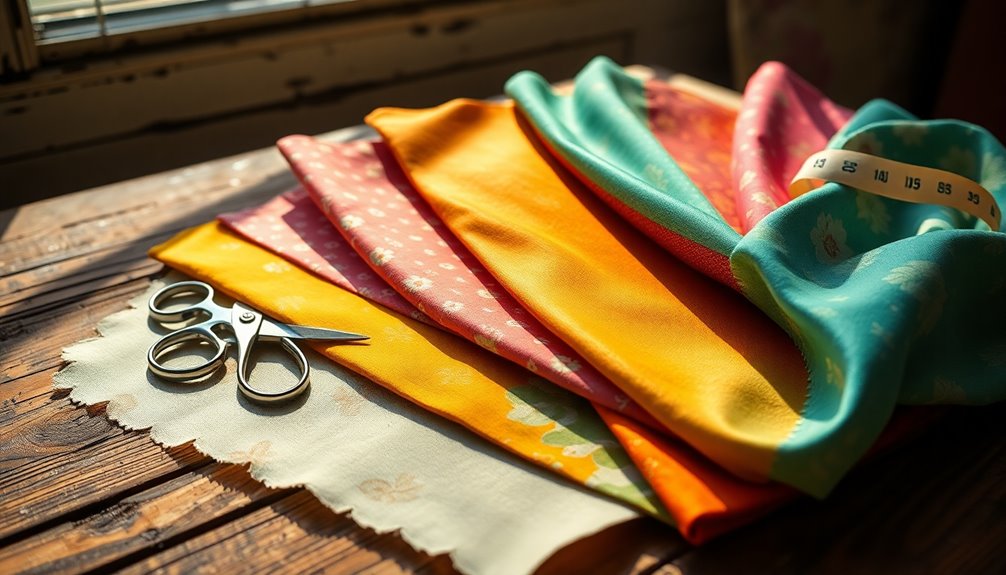
When you're ready to choose the perfect fabric for your DIY project, keep these essential evaluation tips in mind.
First, unroll the fabric to see how it drapes well; different materials behave differently, affecting your project's look.
Next, evaluate the fabric's width, which typically comes in 45 inches or 60 inches, ensuring you buy enough for your design.
Always check the color under natural light to avoid shade discrepancies.
Don't forget to test the stretch by gently pulling the fabric between your fingers; this step is vital for garment designs.
Finally, assess the fabric's texture against your skin to guarantee comfort, especially for pieces you'll wear for long periods.
Following these tips will help you make the best choice!
Frequently Asked Questions
How to Choose the Right Fabric for Your Project?
Choosing the right fabric for your project starts with defining its purpose.
Consider if you need durability for functional items or lighter materials for decorative pieces. Evaluate characteristics like drape and stretch to match your design.
Test the fabric's feel and weight against your skin to guarantee comfort.
Don't forget to factor in care requirements and your budget, so you can maintain the fabric easily without overspending.
Happy sewing!
Which Fabric Is Best for My Sewing Project?
Choosing the right fabric is like picking the perfect paint for a masterpiece; it sets the tone.
Think about what you'll create. If you're sewing something functional, consider sturdy fabrics like canvas or denim. For flowy dresses, lean towards softer materials like cotton or silk.
Don't forget to check the fabric's drape and stretch, as they'll determine how your project turns out. Always pre-wash to guarantee your masterpiece holds up in the wash!
How Do You Determine What Fabric to Use for an Interior Design Project in a Home?
To determine what fabric to use for your interior design project, start by considering the intended use.
You'll want durable materials for upholstery and lighter fabrics for curtains. Evaluate the fabric's weight for stability versus softness.
Don't forget breathability for comfort, especially for cushions. Check the washability for practical maintenance, and explore colors and patterns that enhance your design vision while adding texture.
This way, you'll create a cohesive and inviting space.
How Do I Choose the Right Amount of Fabric?
When it comes to choosing the right amount of fabric, you've got to measure twice and cut once.
Start by checking your project's requirements for yardage based on size and complexity. If you're unsure, grabbing about 2.5 yards gives you some breathing room.
Keep the fabric width in mind, and don't forget to account for patterns or stripes.
For simple tops, aim for 1.5 to 3 yards, while larger projects may need more.
Conclusion
Now that you've explored the essential factors for choosing the right fabric, you're ready to bring your DIY vision to life. Remember, the perfect fabric is like a canvas waiting for your creativity to paint it. Whether you're a seasoned pro or just starting out, selecting the right material will make all the difference in your project's success. So, jump in, trust your instincts, and let your imagination run wild! Happy crafting!

